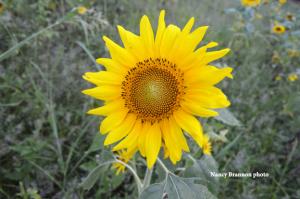By Nancy Brannon
July and early August are the peak time to see sunflowers in full bloom throughout the mid-south. Considered the “happy flower,” sunflowers are a delight for the eyes, plus a dining delight for birds like goldfinches and butterflies like monarchs. They are a favorite food for doves, too, which is the main reason dove-hunting farmers plant them in the mid-south.
Long beloved as part of the rural landscape, sunflowers have been embraced by gardeners as an ornamental plant. Breeders have developed varieties particularly suitable for home gardens.
At the Agricenter in Memphis, Tenn., sunflowers were blooming July 14th and continued to bloom for the next three weeks. Christine Donhardt at the Agricenter said, “This year over 78,000 sunflower seeds were planted at Shelby Farms, Memphis, Tenn., near Germantown Parkway and Walnut Bend, for the community to enjoy. Hundreds of people came out to take their photographs!”
For more pictures see the Agricenter’s sunflower webpage: http://www.agricenter.org/sunflowers?mc_cid=f73a6cb762&mc_eid=00de051db3 or Agricenter’s facebook photo album: https://www.facebook.com/AgricenterInternational/photos
Many thanks to Christine Donhardt at Agricenter International for sharing the photos.
Sunflowers are easy to grow. They need six to eight hours of full sun a day and do well in any well-drained soil. You can sow seeds directly into the garden in the spring when the soil temperature is between 46 and 50 degrees F. Sunflowers can be safely planted up to two weeks before the last expected spring frost. They do fine in soils that are slightly acidic to somewhat alkaline (pH 6.0 to 7.5).
As the plants grow – some up to 8 feet, others reaching 15 feet – mulch and water them regularly, and if taller selections need support, stake them with bamboo and twine. Once sunflowers get started, they can tolerate drought as befits plants whose ancestors grew happily in dry prairie regions.
Contemporary sunflowers trace their ancestry to plants found at archeological sites dating from 3,000 BC. While they grew abundantly on the Great Plains, sunflowers were first purposely cultivated by Native Americans in the Southwest or Mississippi River Valley area as a source of medicine, fiber, seeds, and oil.
The European settlers recognized the value of sunflowers and sent seeds back to Europe. There they found a place in English cottage gardens and even Van Gogh's paintings. However, it was in Russia that the sunflower became a major agricultural crop. They provided a source of oil that could be eaten without breaking church dietary laws. Early in the 20th Century, Russian growers spearheaded the breeding and selection for disease resistance and high oil content. In the 1960s, the U.S. began sustained commercial production of oil seed cultivars to produce vegetable oil.
Sunflower seeds are rich in vitamins, proteins, and minerals, as well as linoleic acid which helps the body metabolize fats properly. They contain about 24 to 27 percent protein, slightly less than an equal weight of ground beef. Sunflower seeds contain about twice the iron and potassium and about four times the phosphorus of beef. Raw sunflower seeds also contain vitamins B and E, and a bit of vitamin A. Sprouted, they also contain vitamin C.
Sources:
Burpee. All About Sunflowers. http://www.burpee.com/gardenadvicecenter/annuals/sunflowers/all-about-sunflowers/article10035.html
Bussell, Gene B. “Grow Sunflowers.” Southern Living. http://www.southernliving.com/home-garden/gardens/grow-sunflowers
Nelms, Kevin, Jon Allison, Bronson Strickland & Bill Hamrick. “Growing and Managing Sunflowers for Dove Fields in the Southeast.” Mississippi State University Extension Service & Natural Resources Conservation Service. https://extension.msstate.edu/sites/default/files/publications/publications/p2725.pdf
July and early August are the peak time to see sunflowers in full bloom throughout the mid-south. Considered the “happy flower,” sunflowers are a delight for the eyes, plus a dining delight for birds like goldfinches and butterflies like monarchs. They are a favorite food for doves, too, which is the main reason dove-hunting farmers plant them in the mid-south.
Long beloved as part of the rural landscape, sunflowers have been embraced by gardeners as an ornamental plant. Breeders have developed varieties particularly suitable for home gardens.
At the Agricenter in Memphis, Tenn., sunflowers were blooming July 14th and continued to bloom for the next three weeks. Christine Donhardt at the Agricenter said, “This year over 78,000 sunflower seeds were planted at Shelby Farms, Memphis, Tenn., near Germantown Parkway and Walnut Bend, for the community to enjoy. Hundreds of people came out to take their photographs!”
For more pictures see the Agricenter’s sunflower webpage: http://www.agricenter.org/sunflowers?mc_cid=f73a6cb762&mc_eid=00de051db3 or Agricenter’s facebook photo album: https://www.facebook.com/AgricenterInternational/photos
Many thanks to Christine Donhardt at Agricenter International for sharing the photos.
Sunflowers are easy to grow. They need six to eight hours of full sun a day and do well in any well-drained soil. You can sow seeds directly into the garden in the spring when the soil temperature is between 46 and 50 degrees F. Sunflowers can be safely planted up to two weeks before the last expected spring frost. They do fine in soils that are slightly acidic to somewhat alkaline (pH 6.0 to 7.5).
As the plants grow – some up to 8 feet, others reaching 15 feet – mulch and water them regularly, and if taller selections need support, stake them with bamboo and twine. Once sunflowers get started, they can tolerate drought as befits plants whose ancestors grew happily in dry prairie regions.
Contemporary sunflowers trace their ancestry to plants found at archeological sites dating from 3,000 BC. While they grew abundantly on the Great Plains, sunflowers were first purposely cultivated by Native Americans in the Southwest or Mississippi River Valley area as a source of medicine, fiber, seeds, and oil.
The European settlers recognized the value of sunflowers and sent seeds back to Europe. There they found a place in English cottage gardens and even Van Gogh's paintings. However, it was in Russia that the sunflower became a major agricultural crop. They provided a source of oil that could be eaten without breaking church dietary laws. Early in the 20th Century, Russian growers spearheaded the breeding and selection for disease resistance and high oil content. In the 1960s, the U.S. began sustained commercial production of oil seed cultivars to produce vegetable oil.
Sunflower seeds are rich in vitamins, proteins, and minerals, as well as linoleic acid which helps the body metabolize fats properly. They contain about 24 to 27 percent protein, slightly less than an equal weight of ground beef. Sunflower seeds contain about twice the iron and potassium and about four times the phosphorus of beef. Raw sunflower seeds also contain vitamins B and E, and a bit of vitamin A. Sprouted, they also contain vitamin C.
Sources:
Burpee. All About Sunflowers. http://www.burpee.com/gardenadvicecenter/annuals/sunflowers/all-about-sunflowers/article10035.html
Bussell, Gene B. “Grow Sunflowers.” Southern Living. http://www.southernliving.com/home-garden/gardens/grow-sunflowers
Nelms, Kevin, Jon Allison, Bronson Strickland & Bill Hamrick. “Growing and Managing Sunflowers for Dove Fields in the Southeast.” Mississippi State University Extension Service & Natural Resources Conservation Service. https://extension.msstate.edu/sites/default/files/publications/publications/p2725.pdf













